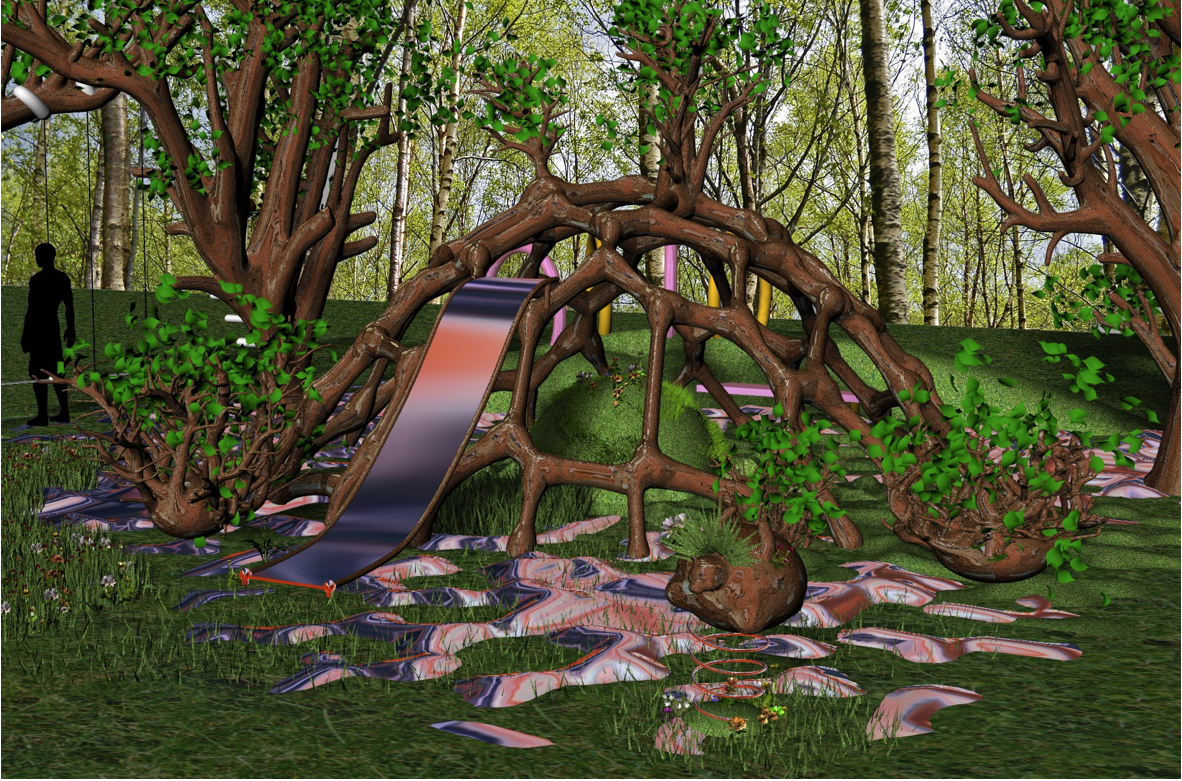M i o m e S p a c e
More than half the world’s population now lives in urban areas. This demographic shift calls for novel formulations of the built environment that are grounded in ecology, and which respond to the precarity of the Anthropocene through the unification of human and environmental health. Miome Space proposes a movement towards new urban ontologies, defined by the celebration of our inherent inseparability from the natural world through the production of living play spaces in cities. The goal of Miome Space is the comprehensive promotion of healthy human development through the mutualistic flourishing of human and non-human ecologies, and the encouragement of generational thinking through the growth of play structures grown from living trees. Through the creation of living play spaces woven out of interconnected organisms at all scales of being, Miome Space unifies urban afforestation, human health, and the promotion of biodiversity.
Recent research in the field of microbiomics has generated an image of human health as a convergence of beings in symbiosis, with microbial partners modulating a diverse array of functions necessary for homeostasis (1). This state of symbiotic homeostasis emerges through the interactions of parasitic, commensal, and mutualistic microorganisms living within, on, and around the human body, and the human body, which exists as both self, and ecosystem. The formulation of human beings as mobile ecologies, both affected by their constituent symbionts, and the spaces in which they reside, allows us to rethink human health as a function of environmental health. Through the formulation of humans as holobionts (1), we are presented with a unique opportunity to unify the design of biodiverse and resilient ecological spaces with the creation of ‘probiotic environments’ for the joint facilitation of human and environmental health (2). As composite organisms woven out of numerous members of the tree of life, the idea of the individual dissolves into miasmic space, in which the self becomes defined through the relationships between cells. This mentality points to new ways of being, and ‘becoming- with’ (3) other beings in the co-creation of ‘Spaceship You’ for the life and the beauty of “Space-Ship Earth” (4). Miome Space synthesizes research in microbiomics (5, 6), which proposes that interactions with plant-associated microorganisms can enhance the health of the human holobiont, and research into the beneficial effects of green spaces in urban environments on childhood development (7), in the creation of holobiont playgrounds for children. These play spaces unite human and environmental health through the production of living probiotic environments for young children to be and grow within the cacophony of urban life.
Arborsculpture, the shaping of living trees, poses a sustainable alternative to conventional playground design, and has the potential to ground human beings in patterns of generation thinking through the perception of ‘plant-time’.
Invivio Design developed a novel approach to the creation of arborsculpture structures, utilizing an aeroponic growth chamber to elongate the roots of fast growing trees, which then harden when exposed to the atmosphere (https://www.invivo-design.com/).
The Fab Tree Hab, designed by Mitchell Joachim, utilizes the technique proposed by invivio design to grow living houses.
Biodesign Challenge 2019 and the Hayground School
Miome Space was selected to participate in the 2019 Biodesign Challenge, through which I was able to propose the creation of living play-scapes at The Hayground School in Bridgehampton, NY. Over this Fall, I have been researching arborsculpture techniques and taking willow cuttings to experiment with growing living structures. I have also been working directly with kids at the school igniting discussuions about the possible future of design as the synthesis of organisms into collaborative ecologies.
S k e t c h e s :
Young arborsculpture play structure grown from insoculated paulownia trees.
Seed balls containing local Black Locust trees. The seeds of the Organism City
R e f e r e n c e s :
1. Guchte, M. Van De, Blottière, H. M., & Doré, J. (2018). Humans as holobionts : implications for prevention and therapy. 4–9.
2. Henaff, Elizabeth. “Invisible Inhabitants.” Journal of Design and Science, jods.mitpress.mit.edu/pub/invisible-inhabitants.
3. Haraway D J 2016 Staying with the trouble: making kin in the Chthulucene Duke University Press, Durham NC
4. Richard, B., & Fuller, B. (1969). Operating Manual For Spaceship Earth. 1–44.
5. Berg, G., Grube, M., Schloter, M., & Smalla, K. (n.d.). THE PLANT MICROBIOME AND ITS IMPORTANCE FOR PLANT AND HUMAN HEALTH Topic Editors. https://doi.org/10.3389/978-2-88919-378-3
6. Ramírez-puebla, S. T., Servín-garcidueñas, L. E., Jiménez-marín, B., Bolaños, L. M., Rosenblueth, M., Martínez, J., … Martínez-romero, E. (2013). Gut and Root Microbiota Commonalities. 79(1), 2–9. https://doi.org/10.1128/AEM.02553-12
7. Engemann, K., Bøcker, C., Arge, L., Tsirogiannis, C., & Bo, P. (2019). Residential green space in childhood is associated with lower risk of psychiatric disorders from adolescence into adulthood. 116(11). https://doi.org/10.1073/pnas.1807504116
8. Rees, T., Bosch, T., & Douglas, A. E. (2018). How the microbiome challenges our concept of self. 1–7.
9. Ferdinand Ludwig http://www.baubotanik.de/index_en.html?open=true













